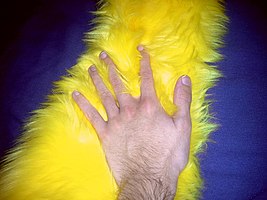Stimming

Self-stimulatory behaviour, also known as stimming[1] and self-stimulation,[2] is the repetition of physical movements, sounds, words, or moving objects. Such behaviours (also scientifically known as 'stereotypies') are found in people with developmental disabilities, and are especially frequent in people on the autism spectrum.[2] People diagnosed with sensory processing disorder are also known to potentially exhibit stimming behaviours.[3] Stimming has been interpreted as a protective response to over-stimulation, in which people calm themselves by blocking less predictable environmental stimuli, to which they have a heightened sensitivity.[2][3] A further explanation views stimming as a way to relieve anxiety and other negative or heightened emotions.[4]
Stimming behaviours can consist of tactile, visual, auditory, olfactory and vestibular stimming. Some common examples of stimming (sometimes called stims[5]) include hand flapping, clapping, rocking, excessive or hard blinking, pacing, head banging, repeating noises or words, snapping fingers, and spinning objects.[6][7]
Stimming is almost always present in people on the autism spectrum but does not necessarily indicate its presence.[8] The biggest difference between autistic and non-autistic stimming is the type of stim and the quantity of stimming.[8] In the Diagnostic and Statistical Manual of Mental Disorders, published by the American Psychiatric Association, stimming behaviour is described as "stereotyped and repetitive motor mannerisms" and listed as one of the symptoms of autism spectrum disorder.[9] Different perspectives suggest that stimming involves both sensory and motor functions. Insufficiencies in these sensorimotor functions can result in stimming behaviours produced by the person as a controllable response.[10]
Adult autistic people have been found to perceive stimming as an important tool for self-regulation.[10] Many people in the autistic community oppose attempts to reduce or eliminate stimming, and contend that attempts to stop people from stimming could be potentially harmful.[11][12]
However, stimming can sometimes be self-injurious, such as when it involves head-banging, hand-biting, excessive self-rubbing, and scratching.[13] While it is difficult to stop stimming entirely, there are many ways to reduce time spent stimming and create safer stimming habits for an individual. Managing the sensory and emotional environment while increasing the amount of daily exercise can increase personal comfort levels of the person which may reduce the amount of time spent stimming. Things such as puzzles, fidget spinners, stress and fidget toys can also be used to help instill safe stimming habits.[14]
See also
References
- ^ Rosalind Bergemann (2013). An Asperger Leader's Guide to Living and Leading Change. Jessica Kingsley Publishers. ISBN 9780857008725.
- ^ a b c Valerie Foley (2011). The Autism Experience. ReadHowYouWant.com. ISBN 9781458797285.
- ^ a b Gretchen Mertz Cowell (2004). Help for the Child with Asperger's Syndrome: A Parent's Guide to Negotiating the Social Service Maze. Jessica Kingsley Publishers. ISBN 9781846420429.
- ^ Eileen Bailey (15 July 2011). "Autism Spectrum Disorders and Anxiety". Health Central. Retrieved 25 March 2014.
- ^ Temple Grandin, PhD (November–December 2011). "Why Do Kids with Autism Stim?". Autism Digest. Archived from the original on 31 March 2014. Retrieved 25 March 2014.
- ^ Eileen Bailey (27 August 2012). "Stimming". Health Central. Retrieved 25 March 2014.
- ^ "Stimming: What autistic people do to feel calmer". BBC. 5 June 2013. Retrieved 25 March 2014.
- ^ a b Lisa Jo Rudy (13 October 2009). "Stimming". About.com. Retrieved 24 March 2014.
- ^ “Autism Spectrum Disorders”, 1994, Diagnostic and Statistical Manual, American Psychiatric Association
- ^ a b Kapp, Steven K.; Steward, Robyn; Crane, Laura; Elliott, Daisy; Elphick, Chris; Pellicano, Elizabeth; Russell, Ginny (2019). "'People should be allowed to do what they like': Autistic adults' views and experiences of stimming" (PDF). Autism. 23 (7): 1782–1792. doi:10.1177/1362361319829628. PMC 6728747. PMID 30818970.
- ^ DeVita-Raeburn, Elizabeth. "Is the Most Common Therapy for Autism Cruel?". The Atlantic. Retrieved 1 October 2017.
- ^ "The controversy over autism's most common therapy | Spectrum | Autism Research News". Spectrum | Autism Research News. 10 August 2016. Retrieved 1 October 2017.
- ^ Fadhil, Tamara (2018). "Live Monitoring System for Recognizing Varied Emotions of Autistic Children". 2018 International Conference on Advanced Science and Engineering (ICOASE). pp. 151–155. doi:10.1109/ICOASE.2018.8548931. ISBN 978-1-5386-6696-8.
- ^ Cunningham, Allison (2008). "Stereotypy in Autism: The Importance of Function". Research in Autism Spectrum Disorders. 2 (3): 469–479. doi:10.1016/j.rasd.2007.09.006. PMC 2598746. PMID 19122856.
